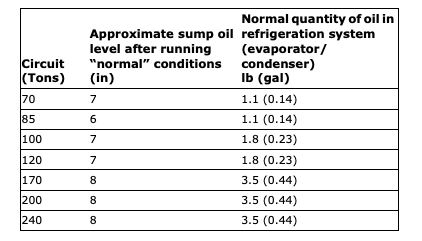Series R® Helical Rotary Chiller: Annual Maintenance
This procedure is the recommended annual maintenance of your equipment. You need to contact a qualified service provider to leak test the chiller, check operating and safety controls, and to inspect electrical components for proper operation. Leak testing my be accomplished using soap solution or with electronic or ultrasonic leak detectors.
Series R® Helical Rotary Chiller: Annual Maintenance
This procedure is the recommended annual maintenance of your equipment. You need to contact a qualified service provider to leak test the chiller, check operating and safety controls, and to inspect electrical components for proper operation. Leak testing my be accomplished using soap solution or with electronic or ultrasonic leak detectors.
Maintenance
Perform all maintenance procedures and inspections at the recommended intervals. This will prolong the life of the chiller and minimize the possibility of costly failures.
Use the “Operator’s Log”, such as that show in chapter “Log and Check Sheet,” p. 124 to record an operating history for unit. The log serves as a valuable diagnostic tool for service personnel. By observing trends in operating conditions, an operator can anticipate and prevent problem situations before they occur. If unit does not operate properly during maintenance inspections, see “Diagnostics,” p. 103.
After unit has been operating for approximately 30 minutes and system has stabilized, check the operating conditions and complete procedures below:
Annual
Annual Procedures:
! WARNING
Hazardous Voltage w/Capacitors!
Failure to disconnect power and discharge capacitors before servicing could result in death or serious injury. Disconnect all electric power, including remote disconnects and discharge all motor start/run capacitors before servicing. Follow proper lockout/ tagout procedures to ensure the power cannot be inadvertently energized. For variable frequency drives or other energy storing components provided by Trane or others, refer to the appropriate manufacturer’s literature for allowable waiting periods for dis
Refrigerant and Oil Charge Management
Proper oil and refrigerant charge is essential for proper unit operation, unit performance, and environmental protection. Only trained and licensed service personnel should service the chiller.
Note: Low temperature applications units will have values that vary from Table 60. Contact your local Trane office for more information.
Table 60
Note: Low temperature applications units will have values that vary from Table 60. Contact your local Trane office for more information.
Lubrication System
The lubrication system has been designed to keep most of the oil lines filled with oil as long as there is a proper oil level in the oil sump.
Oil Sump Level Check
Oil system consists of the following components:
Note: It is recommended to check the oil level in the sump using a sight glass or a manometer, attached to charging hoses.
Important: If levels are outside these ranges, contact your local Trane office.
Condenser Maintenance
Condenser Coil Cleaning
! WARNING
Hazardous Chemicals!
Failure to follow all safety instructions below could result in death or serious injury. Coil cleaning agents can be either acidic or highly alkaline and can burn severely if contact with skin occurs. Handle chemical carefully and avoid contact with skin. ALWAYS wear Personal Protective Equipment (PPE) including goggles or face shield, chemical resistant gloves, boots, apron or suit as required. For personal safety refer to the cleaning agent manufacturer’s Materials Safety Data Sheet and follow all recomme
Clean the condenser coils at least once a year or more frequently if the unit is in a “dirty” environment. A clean condenser coil will help to maintain chiller operating efficiency. Follow the detergent manufacturer's instructions to avoid damaging the condenser coils.
To clean the condenser coils use a soft brush and a sprayer such as a garden pump type or a high-pressure type. A high quality detergent such as Trane Coil Cleaner (Part No. CHM-00255) is recommended.
Note: If detergent mixture is strongly alkaline (pH value greater than 8.5, an inhibitor must be added).
Source: Trane (www.trane.com)

